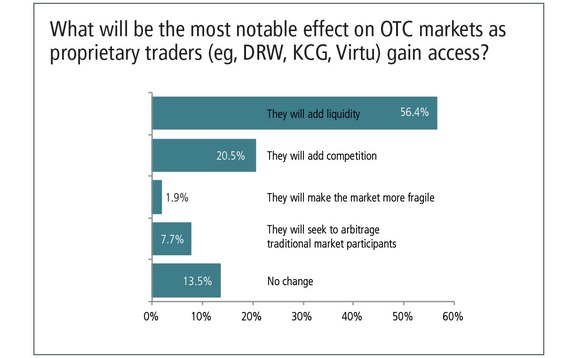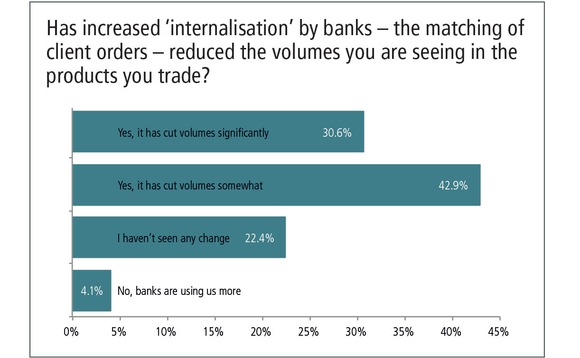
Brokers woo new clients, try not to upset old ones
The swaps market is still bifurcated, but old boundaries are blurring. For now though, at least, all-to-all trading remains a pipe dream for many fixed-income markets

Need to know
- Interdealer brokers are trying to grow and diversify their client base, as banks retreat from certain products and markets.
- In many cases, these new clients are either competitors to the banks, or customers – leaving the brokers with a difficult balancing act.
- BGC and Icap have both allowed Citadel Securities access to interdealer markets in euro interest rate swaps – which Citadel needed in order to start making markets to bank clients on Bloomberg.
- Icap's Frits Vogels says incumbent dealers responded in a "very mature" way.
- Tullett Prebon has announced plans for a new division that will match up buy-side firms directly, replacing the role banks have played.
- The firm's strategy head, Mihiri Jayaweera, says the venture will be limited to products where banks are in retreat, such as corporate bonds. Swaps will be off limits.
- Brokers expect this trend to continue, but say all-to-all trading remains a pipe-dream for many fixed-income markets, where banks will still call the shots.
This article accompanies Risk's 2016 ranking of interdealer brokers. Click here for the full results.
Interdealer brokers traditionally have a pretty distinct customer base. The name gives it away.
But in a world where incumbent dealers are trading less, and regulation requires trading venues to throw their doors open to all participants, brokers have good reason to diversify. They must also tread carefully – the new customers they need to bring on board are either competitors or clients to the incumbents.
"The majority of our business is bank business, so brokers have not been shouting about their new customers – they don't want to saw off the branch they are sitting on," says a London-based partner at one mid-sized brokerage.
As a result, it is not clear how far the brokers have come – or aim to go – particularly in fixed-income markets, where the split between interdealer and dealer-to-client liquidity has been policed most aggressively. Two recent developments are seen by some as evidence of a change.
One is the arrival of Citadel Securities – the market-making arm of the Chicago-based trading and asset management firm – on broker-run swaps trading platforms run by BGC and Icap in Europe this year. The same thing had happened a year earlier in the US, prompting hand-wringing at the brokers and raising hackles at the banks.
The other is Tullett Prebon's announcement in August that it plans to create a new division, Institutional Services, from which the big dealers will be excluded. The broker will intermediate between buy-side firms – on the face of it, replacing the banks that ordinarily play that role.
This shifting client base is almost being forced on us. There are so many changes happening – as a result, primarily, of regulation
Mihiri Jayaweera, Tullett Prebon
Publicly, the brokers involved are trying to play down the significance of these changes. Frits Vogels, the Europe, Middle East and Africa chief executive for global broking at Icap in London, says what traditional dealers feared was an intermingling of dealers and clients in the same liquidity pool – there would be no incentive to provide a tight price to a client if, in another trade, that client could be a competitor.
Citadel was waved onto the platforms because it is no longer seen as a client, he says: "People have understood that Citadel is truly a sell-side firm. Ok – they're not a bank, they have a different business model, but it's not like they are mixing investment and market-making activities in the same unit."
The reaction from the incumbents when Citadel started trading euro swaps was "very mature" he says.
Seen like this, the liquidity pools Citadel has joined remain interdealer markets; nothing has changed.
Big opportunity
Tullett Prebon's London-based head of strategy, Mihiri Jayaweera, also plays down the symbolism of the firm's new venture: she sees it as a big opportunity for Tullett to win new clients and meet a more diverse set of needs, but only where banks are beating a retreat.
"This shifting client base is almost being forced on us. There are so many changes happening – as a result, primarily, of regulation. You've got some dealers pulling out of areas they were in, and in some places clients are under-served. And if we're going to position ourselves to capture this opportunity, then we have to be much more systematic in understanding how the market structure is changing, and what the needs of these clients are," she says.
She is at pains not to paint it as some kind of revolution. Brokers already have a diverse client base, she says – Tullett trades with around 4,000 firms across products and asset classes – and other brokers already have similar units to match trades between non-bank clients.
Most importantly, Tullett's new division will only go where it is wanted – for example, into the corporate bond market, where dealer inventory has shrunk dramatically in recent years: "There are some asset classes where we won't do it – where we don't see potential demand, or because it is the territory of our dealer banks," she says.

It is harder to make the case that nothing is changing here – the new division will explicitly try to match up non-banks – but Tullett's argument is that it can't be stealing the banks' customers, if they are customers the banks are leaving behind.
Some in the industry are not buying the nothing-to-see-here line, though.
In total, Risk spoke to 10 brokers for this article, at seven different firms. Two of those sources pointed to Citadel's arrival in the euro swaps market as evidence of a shift in the relationship between banks and brokers. The Chicago firm may now be recognised as a genuine sell-side player, but for some banks that was beside the point – the only reason it was seeking interdealer liquidity was to hedge trades it wanted to conduct with the banks' traditional clients on Bloomberg. It had already shown it could do that successfully in US dollar swaps.
"Banks are under siege from a regulatory perspective. So, of course, some of them didn't want the competition. No-one wants it: if you and I were selling lemonade on a street corner, we would want to be the only guys selling lemonade," says one New York-based broker.
While Icap's Vogels says dealers behaved maturely in accepting Citadel into the interdealer euro swaps market, others tell a different story. News of Citadel's first interdealer trade – which should have been known only to the two counterparties and its broker – leaked into the market, sources say, causing fierce protests from at least one bank.
Those protests came to naught. The broker did not back down.
Increasing independence
If true, the whole episode could be seen as proof that brokers are becoming more independent, and that many banks are becoming less defensive.
"It's a significant development; much more significant than it was to see Citadel trading US dollar swaps in the US," says a second New York-based broker, citing the fact that US regulation was less ambiguous about the need for platforms to offer impartial access to all participants. In Europe, for a time at least, brokers could simply have strung Citadel along, he argues.
Change is not just visible in the brokers' willingness to shake up competition – and margins – in the interdealer space. Quietly, brokers are also speaking directly to the banks' clients.
"It's changing. It is within our wheelhouse to talk to the buy-side directly, and it is definitely within the objectives of the other brokers to do the same – notwithstanding what they might say publicly," says the first New York-based broker.
The vast majority of our business is interbank today, with a substantial minority dealer-to-client; the trend is clearly more buy-side and less bank. It's hard to be specific on the timeline, but we're heading towards a 70/30 split, or even 60/40, in the next couple of years
David Gibbs, Sunrise Brokers
This trend has a longer history in other asset classes, such as equity derivatives. Brokers in this market have always traded directly with the buy side when the occasion arises, but the number of non-bank customers – and the proportion of business they represent – has grown steadily in recent years, says David Gibbs, managing partner with Sunrise Brokers in London.
"The vast majority of our business is interbank today, with a substantial minority dealer-to-client; the trend is clearly more buy-side and less bank. It's hard to be specific on the timeline, but we're heading towards a 70/30 split, or even 60/40, in the next couple of years," he says.
Part of the reason for the change is that banks are no longer trying to be all things to all people, he adds: they have cut traders, salespeople, and the number of clients they serve. Many of those traders have gone to work at hedge funds, and taken with them the habit of calling up a broker for market colour; those that remain in the banking industry recognise some of their clients might benefit from speaking directly to a broker from time to time, says Gibbs.
Similarly, the plan for Tullett to start matching up non-bank customers would have been impossible until the post-crisis regulatory squeeze, says Jayaweera: "There has been a change in tone. We couldn't have done it six or seven years ago, but banks are now saying ‘We're not going to provide the balance sheet for some of these businesses, and when we do provide it, we'll be doing it for a smaller, more select group of clients'. So there is less sensitivity than there was."

This gradual easing of the bankers' stranglehold is some way from the vision that seemed to animate post-crisis OTC derivatives regulation. In the early years of this decade, the introduction of mandatory clearing and electronic trading for some products promised to unleash a radical re-ordering of the market, with all-to-all liquidity replacing today's bifurcated structure, and broker-run swap execution facilities (Sefs) thrown into direct competition with exchanges and trading platforms such as Bloomberg, MarketAxess and Tradeweb.
That has not happened, and Scott Fitzpatrick, chief executive at TraditionSEF in New York, is not expecting much further change without regulatory intervention to tackle lingering obstacles such as the lack of post-trade anonymity on broker-run Clobs, or the difficulties asset managers face in allocating large Sef trades to their galaxy of end-clients.
"In theory, is all-to-all trading nirvana? Yes. In practice, does it work? Not in very many places," he says. "Regulators have tried to push things in that direction by making products subject to clearing and trading mandates, creating structures such as Sefs that everyone has to use and have open access to – but what you see in practice is a market structure that caters to the type of liquidity people want, and the manner in which they want to trade. If you look forward five years, I think the structure looks very much the same as it does today."
In theory, is all-to-all trading nirvana? Yes. In practice, does it work? Not in very many places
Scott Fitzpatrick, Tradition Sef
His argument – one that has plenty of support – is that brokers and banks will be tied together for some time to come, but in a less-exclusive way. Rather than an OTC market split into interdealer and dealer-to-client trading, Fitzpatrick forecasts one that is split by the needs of the various participants. Some firms will execute big trades on central limit order books (Clobs) run by the brokers, while others will submit a request-for-quote (RFQ) and execute smaller tickets on Bloomberg and its rivals.
"You will see people coming into liquidity pools and trading in the style of those pools. Typically, the buy side will trade through RFQ platforms, but we have seen some of these firms wanting to gain access to new types of liquidity, because they are trading in size and it can be more efficient to get it done in a Clob," he says. "Outside of that, are we going after the Bloomberg and Tradeweb client base? No – the balance is about transitioning new participants into our style of liquidity pool, while maintaining the integrity of that pool. That takes time."
This is not one-way traffic, as the first New York-based broker notes. One of the developments unlocked by mandatory electronic trading is that some smaller banks, which would traditionally have used the broker market, are now submitting RFQs on Bloomberg or Tradeweb, as though they were a buy-side firm.
The brokers' consensus forecast is that these different liquidity pools will persist for as long as market participants have distinct needs – most banks do not want to execute a large hedge by hoovering up the best prices available across the top of several different Clobs; and many buy-side firms are comfortable with RFQs.
But the split may not be strictly between interdealer and dealer-to-client trading; and the interdealer brokers might not strictly be interdealer anymore. They might just be brokers.
Only users who have a paid subscription or are part of a corporate subscription are able to print or copy content.
To access these options, along with all other subscription benefits, please contact info@risk.net or view our subscription options here: http://subscriptions.risk.net/subscribe
You are currently unable to print this content. Please contact info@risk.net to find out more.
You are currently unable to copy this content. Please contact info@risk.net to find out more.
Copyright Infopro Digital Limited. All rights reserved.
As outlined in our terms and conditions, https://www.infopro-digital.com/terms-and-conditions/subscriptions/ (point 2.4), printing is limited to a single copy.
If you would like to purchase additional rights please email info@risk.net
Copyright Infopro Digital Limited. All rights reserved.
You may share this content using our article tools. As outlined in our terms and conditions, https://www.infopro-digital.com/terms-and-conditions/subscriptions/ (clause 2.4), an Authorised User may only make one copy of the materials for their own personal use. You must also comply with the restrictions in clause 2.5.
If you would like to purchase additional rights please email info@risk.net
More on Markets
Review of 2025: It’s the end of the world, and it feels fine
Markets proved resilient as Trump redefined US policies – but questions are piling up about 2026 and beyond
Does crypto really need T+0 for everything?
Instant settlement brings its own risks but doesn’t need to be the default, writes BridgePort’s Soriano
Asset managers prep autocall ETFs with assets tipped to hit $30bn
Actively managed strategies wait in the wings after systematic approach nets Calamos $500m
US insurers turn to short-dated FX forwards as notionals rise
Counterparty Radar: Trades under three months make up nearly 60% of total positions, up from just a third in 2022
Citi launches core inflation QIS
Custom indexes eliminate energy and food prices to ease trading of stickier inflation trends
Analysts dismiss BDC credit quality concerns
Growing private credit worries helped drive losses, but fundamentals are said not to support that view
October’s crash shows crypto has come of age
Ability to absorb $19bn liquidation event marks a turning point in market’s maturity, says LMAX Group's Jenna Wright
From inertia to acceleration: scaling tri-party VM and collateral reuse
Catalysing network effects and expanding non-cash VM at scale








